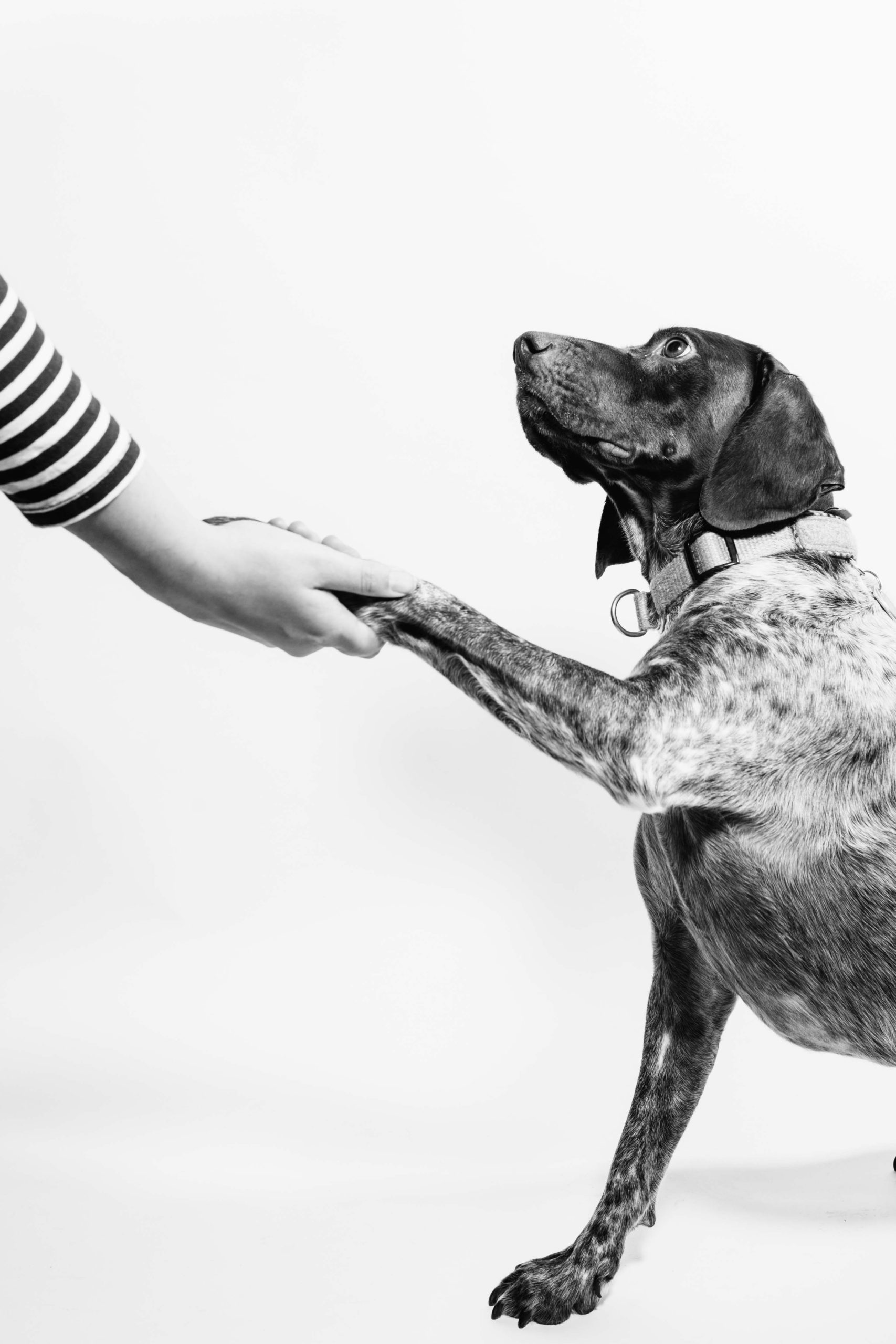Ever wondered what your furry friend is trying to tell you? Puppies have a unique way of expressing themselves through their body language, including calming signals and tail wagging.
A stressed canine may exhibit various behaviors that indicate discomfort or anxiety. For example, puppies might lower their head, tuck their tail between their legs, or even bare their teeth.
These responses can occur in different situations, such as when encountering a stranger or being placed in an unfamiliar context.
Understanding Stressed Dog Body Language: Signs and Indications of Stress:
Stressed puppies often exhibit various signs of anxiety, including tail wagging. Here are some common signs of stress in puppies.
- Tail tucked between the legs: When a dog tucks its tail tightly between its hind legs, it is usually a clear indication of stress. This behavior is commonly observed when a dog feels threatened or fearful. It’s important to note that some breeds naturally have lower tail carriage, so assessing the overall body language is essential.
- Dilated pupils and wide eyes: Heightened anxiety in dogs can be easily detected through their eyes. If you notice your dog’s pupils dilating or their eyes widening, it suggests they are experiencing stress. These visual cues can also accompany other signs of distress, such as panting or trembling.
- Lip licking or yawning: Dogs often use lip licking and yawning as subtle ways to communicate their discomfort or unease. These behaviors may occur even when there is no food involved, indicating that the dog is trying to alleviate stress rather than simply being hungry or tired.
- Raised hackles along the back: Raised hackles refer to the hair standing up along a dog’s back. This response typically occurs when a dog feels threatened or stressed. The raised hair makes the dog appear larger and more intimidating as an instinctual defense mechanism.
Understanding these signals of stress in puppies allows owners to promptly intervene and alleviate their pet’s anxiety. By recognizing these indicators, you can create a calmer environment for your furry companion.
It’s important to remember that each puppy may display different combinations of stress signals based on their personality and past experiences.
Therefore, it’s essential to observe your individual pet closely and consider all relevant factors before drawing conclusions about their emotional state.
If you notice signals of stress in your puppy, it’s crucial to address the underlying causes and provide appropriate support. Here are a few tips to help reduce stress in dogs.
- Create a safe space: Designate a quiet area where your dog can retreat when feeling overwhelmed or anxious. Provide comfortable bedding, toys, and soothing music to promote relaxation.
- Maintain a consistent routine: Dogs thrive on routine, so try to establish regular feeding times, walks, and play sessions. Predictability helps reduce uncertainty and promotes a sense of security.
- Positive reinforcement: Use positive reinforcement techniques to reward desired behaviors and build trust with your dog. This approach encourages them to associate positive experiences with certain situations, reducing stress over time.
- Provide mental stimulation: Engage your dog in mentally stimulating activities like puzzle toys or obedience training exercises. Mental stimulation not only distracts from stressful triggers but also helps tire them out physically and mentally.
- Seek professional help if needed: If your dog’s stress levels persist or worsen despite your efforts, consider consulting with a professional veterinarian or animal behaviorist who can provide personalized guidance and recommend appropriate interventions.
By understanding the signals of stress in dogs and taking proactive steps to alleviate their anxiety, you can create a happier and healthier environment for your beloved pet companions.
Remember that every dog is unique; what works for one may not work for another. It’s important to pay attention to the signals your dog gives you and adjust your training methods accordingly.
Common Causes of Stress in Dogs: Identifying Triggers
Just like humans, dogs can experience stress. It is important for dog owners to be aware of the common causes of stress in dogs and to identify the triggers that can lead to signals of a stressed dog.
Loud Noises
One of the most common triggers for stress in dogs is loud noises, such as thunderstorms and fireworks. These loud signals can startle even the most stoic of dogs, leading to trembling, panting, and other signs of distress.
To help alleviate this stress, consider creating a safe space for your dog during thunderstorms or fireworks displays. This could be a cozy room with minimal noise or even a specially designed crate where they feel secure.
Changes in Routine
Another trigger that can cause stress in dogs is changes in routine. Dogs thrive on predictability and structure, so any significant deviation from their usual schedule can disrupt their sense of security.
Moving to a new house or introducing major changes such as a new family member or pet can be particularly stressful for dogs.
To ease this transition, try maintaining some semblance of routine amidst the changes. Stick to regular feeding times and walks as much as possible, providing your dog with a sense of familiarity and signals.
Lack of Socialization
A lack of socialization or exposure to new environments can also contribute to stress in dogs. Dogs are naturally curious creatures who benefit from positive interactions with other animals and people.
When they are not given ample opportunities to socialize or explore different environments early on, they may become anxious when faced with unfamiliar situations later in life.
Dog parks, obedience classes, and playdates with well-behaved canine companions are great ways to introduce your dog to new experiences and reduce their stress levels. These experiences provide important signals for dogs.
Separation Anxiety
Separation anxiety is a common cause of stress when dogs are left alone. Dogs are pack animals, and being separated from their human family members can trigger feelings of fear and insecurity.
Signs of separation anxiety may include excessive barking, destructive behavior, or house soiling. To help alleviate this stress, gradually acclimate your dog to being alone by starting with short periods of time apart and gradually increasing the duration.
Providing them with interactive toys or leaving the radio on for background noise can also help distract them during your absence. These signals of separation anxiety should not be ignored.
Identifying the triggers that cause stress signals in dogs is crucial for dog owners to ensure the well-being of their furry companions.
By understanding these common causes – loud noises, changes in routine, lack of socialization, and separation anxiety – dog owners can take proactive steps to minimize stress and create a safe environment for their four-legged friends.
Remember to always consult with a professional if you notice persistent signs of stress or if you need further guidance on how to support your stressed dog’s body language in dangerous situations.
Decoding Stressed Dog Body Language: Abnormal Posture and Behavioral Changes
It is crucial to pay attention to a dog’s body language and posture, as these signals reveal their emotions. Dogs have a unique way of communicating their feelings, and their body posture can indicate stress or anxiety.
Crouched Posture with Lowered Head: Fear or Submission
A crouched posture with a lowered head is often a signal that a dog is experiencing fear or submission. When dogs feel threatened or overwhelmed, they may hunch down close to the ground with their head lowered.
This defensive stance serves as a way for them to protect themselves and avoid confrontation. It is essential not to approach dogs exhibiting this posture too quickly or forcefully, as it may escalate their anxiety further.
Excessive Panting, Drooling, or Shaking: Signs of Stress
Excessive panting, drooling, or shaking can be clear signals that a dog is under stress. Just like humans sweat when nervous or anxious, dogs release excess heat through panting and may salivate more than usual when stressed.
Trembling or shaking can occur due to heightened levels of anxiety in dogs. If you notice these signs in your furry companion, it’s important to create a calm environment for them and provide reassurance.
Avoidance Behavior: Hiding or Trying to Escape
High levels of anxiety in dogs often manifest as avoidance behavior. They may try to hide in confined spaces such as under furniture or behind curtains. Some dogs might even attempt to escape by pawing at doors or digging beneath fences.
These actions serve as coping mechanisms for them to seek safety and solitude when feeling overwhelmed by stressful situations. Understanding and respecting their need for space is crucial during these times.
Aggression towards People or Other Animals: Extreme Stress
Extreme stress can lead to aggression in dogs. When they feel threatened or cornered, they may exhibit aggressive behaviors as a defense mechanism. This can include growling, barking, lunging, or even biting.
It is important to remember that aggression in dogs is often a result of fear or anxiety rather than inherent maliciousness. If you encounter a dog displaying aggressive behavior, it’s best to give them space and consult with a professional dog trainer or behaviorist for guidance.
Vocal Expressions of Stress: Whining, Barking, or Growling:
Whining, barking, growling, and howling are all vocal expressions that dogs use to communicate their stress levels. Understanding these sounds can help dog owners recognize when their furry friends are feeling uncomfortable or distressed.
Whining as an Expression of Discomfort or Distress
One common vocalization that stressed dogs may exhibit is whining. When a dog whines, it can be an indication that they are experiencing discomfort or distress. This could be due to various factors such as fear, anxiety, pain, or even separation anxiety.
For example, if a dog is left alone for long periods without any interaction or stimulation, they may start whining to express their loneliness and longing for companionship. Similarly, if a dog is in pain due to an injury or illness, they may whine to communicate their discomfort.
Excessive Barking: Frustration or Anxiety?
Excessive barking is another vocal expression often observed in stressed dogs. Dogs may bark excessively when they feel frustrated or anxious about something in their environment.
It could be triggered by changes in routine, unfamiliar people or animals entering their territory, loud noises like thunderstorms or fireworks, and more.
To determine whether excessive barking is a sign of stress in your dog, consider the context and duration of the behavior.
If your dog’s barking seems disproportionate to the situation at hand and persists for extended periods without any apparent reason (such as protecting their territory), it could be a manifestation of stress.
Growling: A Verbal Warning Sign
When dogs feel threatened or stressed by certain situations or individuals around them, they often resort to growling as a warning sign. Growling serves as a way for dogs to communicate that they are uncomfortable and would prefer not to engage further.
For instance, if a person approaches a stressed dog too quickly or invades their personal space, the dog may growl to convey their unease. It is crucial for dog owners and others to respect this warning and give the dog space.
Howling: A Vocal Release of Stress
In some cases, dogs may resort to howling when they are experiencing high levels of stress or anxiety. Howling can be a form of vocal release for dogs, allowing them to express their emotions and alleviate some tension.
For example, if a dog feels isolated or separated from their litter mates or human family members, they may howl as a way to seek reassurance and connection. Certain breeds are more prone to howling due to genetic factors.
Understanding these vocal expressions of stress in dogs can help owners better interpret their pets’ body language and respond appropriately.
By recognizing signs such as whining, excessive barking, growling, or howling, owners can take steps to reduce stressors in their dogs’ environment and provide comfort and support when needed.
Remember that every dog is unique, so it’s essential to observe your own pet’s behavior patterns and consult with a professional if you have concerns about your furry friend’s well-being.
Physical Indicators of Stress in Dogs: Anxiety or Fear
Stress in dogs can manifest itself in various ways, and understanding the physical indicators is crucial for pet owners. When dogs experience anxiety or fear, their bodies often display telltale signs that can help us recognize their stress levels.
By paying attention to these physical cues, we can better understand our furry friends’ needs and provide them with a supportive environment.
Trembling or shaking is one of the most common physical manifestations of stress in dogs. Just like humans, dogs may shake when they feel anxious or fearful.
This trembling can range from subtle quivering to more pronounced shaking, depending on the dog’s stress level and temperament. It’s important not to dismiss this behavior as mere excitement; it could be a sign that your pet is feeling overwhelmed.
Another physiological response to stress in dogs is an increased heart rate and rapid breathing. When faced with a perceived threat or stressful situation, a dog’s heart rate will elevate, causing rapid breathing.
Pay close attention to your dog’s chest movements and listen for any changes in their breathing patterns. If you notice excessive panting or irregular breaths during non-strenuous activities, it could indicate heightened stress levels.
Stressed dogs may also exhibit loss of appetite or engage in excessive grooming as coping mechanisms. These behaviors are often stress-related and should not be ignored.
A sudden decrease in food intake or excessive licking and biting at their fur can be signs that your dog is experiencing anxiety or fear. Monitor their eating habits closely and look out for any changes in weight that might indicate ongoing stress.
One noticeable behavior displayed by stressed dogs is pacing back and forth. This repetitive movement serves as an outlet for their nervous energy and can be observed when they feel uneasy or threatened by their environment.
If you observe your dog pacing excessively without any apparent reason, it might be a clear indication of their stress levels.
Understanding the physical indicators of stress in dogs is crucial for providing them with the care and support they need.
By recognizing signs such as trembling or shaking, increased heart rate and rapid breathing, loss of appetite or excessive grooming, and pacing back and forth, you can take steps to alleviate their anxiety or fear.
Remember that every dog is unique, and their responses to stress may vary. It’s essential to consider your pet’s behavior in context, taking into account factors such as their environment, past experiences, and overall well-being.
By being attentive to your dog’s body language and responding appropriately, you can help create a calm and secure environment where they feel safe.
Recognizing Relaxed, Happy, and Playful Dog Body Language: Calming and Stress Signals
A stressed dog can exhibit various body language cues that indicate their emotional state. It is crucial for dog owners and enthusiasts to be able to recognize these signals in order to understand their furry friends better and provide them with the care they need.
Relaxed Body Posture: A Sign of Happiness
When a dog is feeling content and at ease, their body posture reflects this positive state of mind. A relaxed dog will have loose muscles throughout their body.
Their stance may be upright or slightly leaning forward with weight evenly distributed on all four legs. This indicates that the dog feels comfortable in its surroundings and is not experiencing any stress or tension.
Play Bows: Inviting Playfulness
One endearing behavior often seen in happy dogs is the play bow. This gesture involves lowering the front end of the body while keeping the rear end up in the air.
It’s an invitation for playtime with either other dogs or humans. When a dog engages in play bows, it demonstrates their desire for interaction, fun, and socialization.
Soft Eye Contact: Calm Demeanor
A dog’s eyes can reveal a lot about its emotions. When a dog looks at you with soft eyes – relaxed eyelids without intense staring – it signifies a calm demeanor and friendly intentions.
This gentle gaze indicates trust and comfort in your presence. It’s important to reciprocate this eye contact positively to reinforce your bond with your furry companion.
Gently Wagging Tail: Expressing Happiness
The tail wag is one of the most recognizable expressions of canine happiness. A happy dog will wag its tail gently from side to side or in broad sweeps depending on its breed. This wagging motion signifies their joy and contentment.
However, it’s essential to consider the entire body language of the dog when interpreting tail wagging, as different speeds or positions can convey different messages.
Rolling Onto Their Back: Trust and Relaxation
When a dog rolls onto its back, exposing its belly, it is a clear sign of trust and relaxation. This behavior is often seen during playtime or when receiving affection from their human companions.
By exposing their vulnerable underside, dogs are displaying their trust in you and allowing themselves to be in a vulnerable position. It’s important to respect these gestures and handle them gently.
Understanding these calming signals and happy dog body language cues can greatly enhance your communication with your furry friend.
By recognizing when they are relaxed, inviting playfulness, displaying calm eye contact, expressing happiness through tail wagging, or showing trust by rolling onto their back, you can better respond to their needs and ensure a harmonious bond between humans and dogs.
So next time you interact with your pup or encounter a canine companion on your walks, pay close attention to their body language – it’s their way of speaking without words!
Helping Your Stressed Dog: Strategies for Relief and Conclusion:
In conclusion, understanding and recognizing stressed dog body language is crucial for providing relief to your furry friend. By identifying the signs and indications of stress, such as abnormal posture and behavioral changes, vocal expressions like whining or growling, and physical indicators like anxiety or fear, you can take proactive steps to alleviate their distress.
To help your stressed dog find relief, it is important to create a calm and safe environment by removing any triggers that may be causing their stress. Providing them with plenty of exercise, mental stimulation, and a consistent routine can also help reduce their anxiety levels.
Learning to recognize relaxed, happy, and playful dog body language can assist you in understanding when your dog is feeling more at ease. Calming signals such as yawning or turning away can indicate that they are starting to relax.
Remember that each dog is unique, so it’s essential to observe your own pet’s individual body language cues. By paying attention to their specific signals of stress or relaxation, you will be better equipped to provide the necessary support.
If you have tried various strategies but still struggle with managing your dog’s stress levels effectively, seeking professional guidance from a veterinarian or certified animal behaviorist can be beneficial. They can provide personalized advice tailored specifically to your dog’s needs.
By implementing these strategies and being attuned to your stressed dog’s body language cues, you will be able to create a happier and healthier environment for them. Remember that patience and consistency are key when helping your furry companion overcome stress.
FAQs
Q: How long does it take for a stressed dog to recover?
A: The recovery time for a stressed dog varies depending on the individual circumstances. Some dogs may bounce back quickly within days or weeks with appropriate care and intervention. However, others may require more time and patience before they fully recover from their stressors.
Q: Can stress in dogs lead to health issues?
A: Yes, prolonged stress in dogs can potentially lead to various health issues. Chronic stress can weaken their immune system, making them more susceptible to illnesses. It can also contribute to behavioral problems and negatively impact their overall well-being.
Q: Are there any natural remedies for reducing dog stress?
A: There are several natural remedies that may help reduce dog stress, including aromatherapy, herbal supplements, and calming pheromone diffusers. However, it is important to consult with a veterinarian before introducing any new treatments or supplements to ensure they are safe for your specific dog.
Q: Can I use exercise as a way to relieve my dog’s stress?
A: Yes, regular exercise is an excellent way to help relieve your dog’s stress. Physical activity helps release endorphins, which promote feelings of happiness and relaxation. Engaging in activities like walks, playtime, or interactive toys can be beneficial for both mental and physical stimulation.
Q: What should I do if my stressed dog shows aggression towards others?
A: If your stressed dog displays aggression towards others, it is crucial to seek professional guidance from a certified animal behaviorist or trainer experienced in working with aggressive dogs. They can assess the situation and provide you with appropriate techniques and strategies to manage your dog’s behavior safely.



